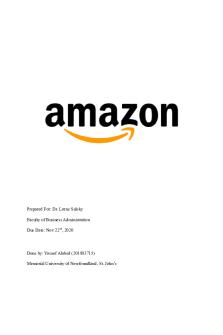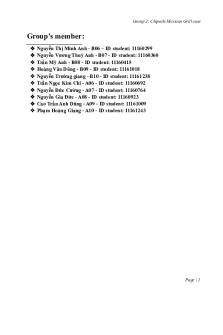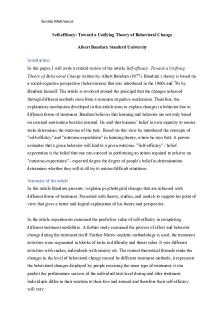Individual Assignment Upload PDF

| Title | Individual Assignment Upload |
|---|---|
| Author | Ellie Taylor-Nobbs |
| Course | TOURISM AND HOSPITALITY CONSULTANCY |
| Institution | University of Surrey |
| Pages | 4 |
| File Size | 84.9 KB |
| File Type | |
| Total Downloads | 109 |
| Total Views | 168 |
Summary
Crafting Strategy by Henry Mintzberg
Critical Review...
Description
Crafting Strategy by Henry Mintzberg Critical Review
Submission Date: 14th November 2017-11-08 Word Count:998
Business strategy formulation has seen significant evolvement and changes in recent years. It has been critically studied and the theories established often suggest varying approaches to the best outcome to form a businesses strategy. As a result, the definition for business strategy has become unclear and often contradicting. Nevertheless, the underpinning theory of The Whittington Model(2000) allows theories to be categorised within the following two schools: whether the process is prescriptive or emergent and if the outcome is solely forprofit maximisation or a pluralistic result. Focusing to a greater extent on the process variable of the model, we are aware there are two ends of the scale in which a theory can be defined. First strategy can be prescriptive and “involves intentional formulation or planning” (Johnson,2013). Deliberate strategy involves calculated planning of detailed objectives, goals and processes following assessment of the organisations’ resources and competitors. The majority of strategists have formulated theories based around the deliberate process including Ansoff(1979) whose theory dates back to 1979 and states that prescriptive approach examines solely where we are now to define goals. And more recently Professor Michael Porter(1996) who summarises that managing a specific fit across all of the company’s activities enhances both competitive advantage and future sustainability. In contrast, the concept whereby the final objective is unclear and the elements are developing during the process, using previous experiences and outlook for the future, is recognised as emergent strategy. Emergent strategy focuses less on the final objective and more on a series of experimental approaches to achieve success (Lynch,2000). When referring to Henry Mintzberg’s article, Crafting Strategy (1987), it is clear that he begins by emphasising the dominance of deliberate strategic planning in most modern theories. He states, “the planning image, long popular in the literature, distorts these processes and thereby misguides organisations” this would suggest that he considers the emergent process to be more effective. Yet the understanding is not as simple as being at either extreme end of the process spectrum. As Mintzberg (1987) outlines, an individual or firm must “walk on two feet, one deliberate, the other emergent” otherwise reinforced through his grassroots approach to strategic management. Like weeds, “strategies grow and form in all kind of places” showing the significance of deliberately emergent strategies is fundamental to Mintzberg. This point was elaborated in more detail by Mintzberg and Walters(1985) as realised strategy. Mintzberg (1987) stresses that “purely deliberate strategy making precludes learning, so purely emergent strategy making precludes control” so it would be simple-minded to position his article in the emergent side of the process debate only. Mintzberg has an ardent preference towards emergent strategy but believes strategists are to be more a combination of both and by coupling emergent and prescriptive strategic management leads to triumph and success. Another influential writer of strategy theory Heracleous(1998) reinforced Mintzberg’s(1987) view that “strategic planning and thinking are two distinct but
related processes” and through his work agrees with Mintzberg that a firm’s business model and unpredictable environment can heavily impact the perfect method for strategy generation. Henry Mintzberg is a significant figure in business strategy history due to his somewhat unconventional view on cultivating strategy. A strength of his article is that his outlook is less rigid in comparison to many other theoreticians. By developing strategies emergently is important to Mintzberg, yet his theory is flexible in how companies do this. Various companies craft their strategy differently and flexibility in emergent influence can impact this development. Throughout his thesis Mintzberg presents the flexibility of his theory by mentioning various ways to craft strategy. Firstly, Mintzberg introduces quantum leaps in planning. Research conducted by Miller and Friesien(1980) distinguished quantum leaps as “clear periods of stability and change”. This identifies that for some businesses there are rarely major shifts in strategic orientation but it can emerge as a result of various influences. Miller and Friesen(1980) are two of very few theoreticians who agree with Mintzberg that a strategic revolution can take place suddenly displaying an example that emergent strategic management isn’t occurring continually but can be introduced abruptly. On the other hand, Mintzberg(1987) acknowledges that other firms are contrasting in a way that they “flit from one idea to another and never settle down” joined with knowledge and experience this can lead to success also. This emphasises that emergent influences can be in varying proportions and his theory’s rigidness is less prominent. Within the article there are plenty of case study examples which fit the emergent process of strategy. Unfortunately, they all are large, mass production companies including General Motors and Air Canada. This displays a weakness that in order to be effective at emergent strategy the CEO must require a wealth of experience and expertise and the firm must be well established. Mintzberg(1987) indicates this himself in remarks such as “everything has to do with your knowledge” or “the words associated with craft: dedication, experience, involvement with the material”. This highlights a downfall that managers or CEOs of smaller, newer firms will find it almost impossible to adopt the principle of crafting strategy due to their lack of time in the business, absence of industry experience and knowledge shortfall. By looking at it a different way, using such well-established examples might mean Mintzberg lacks depth on his view of emergent strategy for SMEs. Instead of simply believing that SMEs attempting an emergent process are set up to fail, he may have had little experience studying smaller businesses to comment. The opinion of Bhide(1994), following research into business start-ups, was that “founders who spent a long time in study, reflection and planning were no more likely to survive their first three years than people who seized opportunities without planning”. This shows that a weakness in the thesis of Henry Mintzberg is not only the absence of discussion regarding SMEs but the lack of clarity regarding it.
To conclude, Henry Mintzberg provides an unorthodox overview of business strategy focusing his ideas towards emergent processes whilst simultaneously addressing the importance of prescriptive planning.
References Ansoff, H. (1979) Strategic Management. Basingstoke: Macmillan Bhide, A. (1994). ‘How Entrepreneurs Crafts Strategies That Work’. Harvard Business Review. 72(2). Pg. 150 Heracleous, L (1998). ‘Strategic Thinking or Strategic Planning?’. Long Range Planning. 31(3). Pg. 481-487 Johnson, G. (2013) Exploring Strategy Text & Cases. Harlow: Pearson Education. Lynch, R. (2000). Corporate Strategy, 4th Edn. Harlow: FT Prentice Hall Miller, D. and Friesen, P. (1980). ‘Momentum and Revolution in Organisational Adaption’. Acad Manage J. 23(4). Mintzberg, H. (1987). ‘Crafting Strategy’. Harvard Business Review. 65(3). Mintzberg, H and Walters, J. (1985). ‘Of Strategies, Deliberate and Emergent’. Strategic Management Journal. 6(3). Pg. 257-272 Porter, M. (1996). ‘What is Strategy?’. Harvard Business Review. 74(6) Whittington, R. (2000). What is Strategy - and Does it Matter?. 2nd ed. London: Cengage Learning....
Similar Free PDFs

Individual Assignment Upload
- 4 Pages

Upload 5 - Assignment answers
- 3 Pages

Individual Assignment
- 26 Pages

Individual Assignment
- 20 Pages

Individual assignment
- 5 Pages

Individual assignment
- 3 Pages

MGT 162 INDIVIDUAL ASSIGNMENT
- 24 Pages

finance - individual assignment
- 7 Pages

Mkt individual assignment
- 4 Pages

BUS assignment individual
- 7 Pages

Report - Assignment 2 : Individual
- 11 Pages

Individual Assignment 1
- 1 Pages
Popular Institutions
- Tinajero National High School - Annex
- Politeknik Caltex Riau
- Yokohama City University
- SGT University
- University of Al-Qadisiyah
- Divine Word College of Vigan
- Techniek College Rotterdam
- Universidade de Santiago
- Universiti Teknologi MARA Cawangan Johor Kampus Pasir Gudang
- Poltekkes Kemenkes Yogyakarta
- Baguio City National High School
- Colegio san marcos
- preparatoria uno
- Centro de Bachillerato Tecnológico Industrial y de Servicios No. 107
- Dalian Maritime University
- Quang Trung Secondary School
- Colegio Tecnológico en Informática
- Corporación Regional de Educación Superior
- Grupo CEDVA
- Dar Al Uloom University
- Centro de Estudios Preuniversitarios de la Universidad Nacional de Ingeniería
- 上智大学
- Aakash International School, Nuna Majara
- San Felipe Neri Catholic School
- Kang Chiao International School - New Taipei City
- Misamis Occidental National High School
- Institución Educativa Escuela Normal Juan Ladrilleros
- Kolehiyo ng Pantukan
- Batanes State College
- Instituto Continental
- Sekolah Menengah Kejuruan Kesehatan Kaltara (Tarakan)
- Colegio de La Inmaculada Concepcion - Cebu



